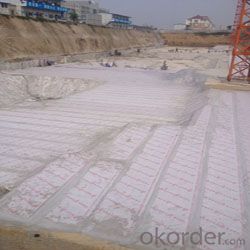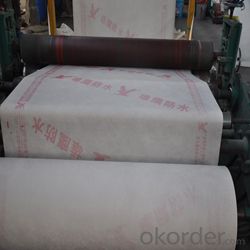High polymer waterproof membrane PP and PE compound
- Loading Port:
- Qingdao
- Payment Terms:
- TT OR LC
- Min Order Qty:
- -
- Supply Capability:
- 1100000 m²/month
OKorder Service Pledge
OKorder Financial Service
You Might Also Like
High Polymer polyethylene polypropylene composite
waterproof membrane
PP+PE+PP composite waterproof membrane is made by multipleply different materials,
especially its aging and weathering resistance layer enables the membrane possess
more longer effective age. It can bond with many kinds of adhesions, firm and secure.
In case of cement-base, cementations agent can be used, the cementationsagent
can easily enter into the non-woven felt layer, forms a well-combination with cement
after solidification, permanent durability.
1.Specifications:
2.Core Material: PE, EVA
3.Color: black, white, green, grey
4.Weight: 300g/m2-800g/m2
5.Length: 100M, 50M
6.Width: 1.15M, 1.20M, 1M
7.Thickness: 0.6mm-1.5mm
8.Technics: Heat synthesis
9.Payment: T/T
10.Port: Qingdao
11.Origin: CHINA
12.Packaging & Delivery: Packed in roll, will deliver after 7-14 days after receive the prepayment

Characteristic:
1. Non-toxic, no pollution, environmental protecting product.
2. Can be used for many different surfaces, especially for cement basement.
3. Tough, impermeable, multi-layered sheet;
4. High tension strength, good cold flexibility.
Application:
Products used in roofing, basement, restroom, water conservation, warehouse to
protect structure from water infiltration.
Construction:
1.The application is simple and no-pollution. It is mainly used in the middle of building
for waterproofing. On this layers of protection and decoration are needed;
2. When application, pour the adhesive materials homogeneously on the smooth roof
deck, then roll the membrane to make is fully adhered to the deck.
3. The adhesive materials are usually made form cement or other building glue

- Q:Can waterproofing membranes be used on stormwater management systems?
- Yes, waterproofing membranes can be used on stormwater management systems. Waterproofing membranes are commonly used to prevent water infiltration and protect structures from water damage. In the case of stormwater management systems, which are designed to capture, store, and manage rainwater runoff, waterproofing membranes can be used to create a watertight seal and prevent leaks or seepage. Stormwater management systems often include components such as retention ponds, infiltration basins, or underground storage systems. These components need to be properly sealed to ensure that the collected stormwater is contained and managed effectively. Waterproofing membranes, when installed correctly, can provide an impermeable barrier that prevents water from escaping or infiltrating the system. Using waterproofing membranes on stormwater management systems offers several benefits. Firstly, it helps to maintain the integrity and functionality of the system by preventing leaks or seepage that may compromise its performance. This ensures that the stormwater is effectively captured and managed, reducing the risk of flooding or erosion. Additionally, waterproofing membranes can extend the lifespan of stormwater management systems by protecting them from water damage. Water infiltration can lead to structural deterioration, corrosion, or the growth of mold and mildew, which can all weaken the system over time. By creating a waterproof barrier, the membranes help to preserve the structural integrity of the components, increasing their longevity and reducing maintenance requirements. Furthermore, using waterproofing membranes on stormwater management systems can also contribute to environmental sustainability. By effectively containing and managing stormwater runoff, these systems help to reduce water pollution and improve the quality of natural water bodies. Waterproofing membranes play a crucial role in preventing stormwater from carrying pollutants, such as chemicals or sediment, into rivers, lakes, or oceans. In summary, waterproofing membranes can be used on stormwater management systems to create a watertight seal, prevent leaks, and protect the components from water damage. By providing an impermeable barrier, these membranes help to maintain the functionality and integrity of the system, extend its lifespan, and contribute to environmental sustainability by reducing water pollution.
- Q:Can waterproofing membranes be used on concrete tunnels?
- Concrete tunnels can benefit from the use of waterproofing membranes. These membranes are commonly employed to prevent water infiltration in various structures, including concrete tunnels. They are applied on the outside of the tunnel walls and can be made from different materials like bitumen, PVC, or EPDM. Their purpose is to stop water from seeping through the concrete. By creating a waterproof layer, these membranes safeguard the tunnel against water damage, such as corrosion, decay, and leaks. Moreover, they act as a protective shield against other sources of moisture, like groundwater or surface water. It is crucial to select a suitable waterproofing membrane that matches the specific conditions and requirements of the concrete tunnel, taking into consideration factors such as water pressure, chemical exposure, and temperature changes. To ensure the effectiveness and long-term durability of the waterproofing membrane in safeguarding the concrete tunnel from water ingress, proper installation and regular maintenance are essential.
- Q:Can a waterproofing membrane be painted or covered with other materials?
- Yes, a waterproofing membrane can be painted or covered with other materials. However, it is important to ensure that the paint or covering material used is compatible with the membrane and does not compromise its waterproofing properties. It is recommended to consult the manufacturer's guidelines or seek professional advice to ensure proper application and maintenance of the waterproofing membrane.
- Q:Can a waterproofing membrane be used on bridge decks?
- Yes, a waterproofing membrane can be used on bridge decks. Bridge decks are exposed to various weather conditions, including rain, snow, and ice, which can cause damage over time. Applying a waterproofing membrane on bridge decks can help to protect the concrete from moisture penetration, preventing deterioration and extending the lifespan of the bridge. Additionally, the waterproofing membrane serves as a barrier against chloride ions, which can accelerate the corrosion of reinforcing steel in the bridge deck. Therefore, using a waterproofing membrane on bridge decks is a common practice in bridge construction and maintenance to ensure their durability and longevity.
- Q:Are there any specific maintenance requirements for a waterproofing membrane?
- Yes, there are specific maintenance requirements for a waterproofing membrane. Regular inspections should be conducted to check for any signs of damage or deterioration, such as cracks or leaks. Any debris or standing water should be promptly removed to prevent potential damage. Additionally, it is important to follow the manufacturer's guidelines for cleaning and maintenance, which may include periodic cleaning with mild detergents and avoiding the use of harsh chemicals or abrasive cleaning tools.
- Q:Can a waterproofing membrane be used in swimming pools or other water features?
- Yes, a waterproofing membrane can definitely be used in swimming pools or other water features. In fact, it is highly recommended to use a waterproofing membrane in these areas to prevent water leakage and damage. A waterproofing membrane acts as a barrier between the water and the surrounding structures, ensuring that the water is contained within the pool or water feature. It helps to prevent water seepage, which can cause structural damage and lead to costly repairs. Additionally, a waterproofing membrane also helps to protect the pool or water feature from the harsh chemicals used for water treatment, ensuring its longevity and durability. Therefore, using a waterproofing membrane is a crucial step in the construction or renovation of swimming pools or other water features to ensure their functionality and longevity.
- Q:Can a waterproofing membrane be used for foundation walls and footings?
- Yes, a waterproofing membrane can be used for foundation walls and footings. A waterproofing membrane is a thin layer of material, typically made of rubberized asphalt or polymer-modified bitumen, that is applied to the exterior surface of foundation walls and footings to prevent water penetration. It acts as a barrier, preventing water from seeping into the foundation and causing moisture-related issues such as dampness, mold, and structural damage. The waterproofing membrane is typically applied to the foundation walls and footings during the construction phase, either before or after the concrete is poured. It is important to ensure that the membrane is properly installed and sealed to provide effective waterproofing. The membrane is also commonly combined with other waterproofing techniques such as drainage systems and sump pumps to provide comprehensive protection against water intrusion. Using a waterproofing membrane for foundation walls and footings is a common practice in construction, especially in areas with high water tables or heavy rainfall. It is an effective and reliable method to prevent water damage and increase the longevity of the foundation. Properly waterproofing the foundation walls and footings is essential for maintaining a dry and structurally sound building.
- Q:Can a waterproofing membrane be used on precast metal surfaces?
- Precast metal surfaces can benefit from the application of a waterproofing membrane. These membranes are specifically designed to create a protective layer that stops water from penetrating the surface. They can be used on various types of surfaces, including precast metal. Waterproofing membranes are typically made from materials like bitumen, liquid coatings, or synthetic rubber. These materials form a barrier that prevents water and moisture from causing damage. When a waterproofing membrane is applied to precast metal surfaces, it helps to prevent corrosion, protects against water damage, and improves the overall durability and lifespan of the metal structure. However, it is crucial to select a waterproofing membrane that is compatible with the specific type of precast metal surface. Additionally, proper surface preparation and application techniques must be followed to ensure optimal performance.
- Q:Can a waterproofing membrane be applied to tiled surfaces?
- Certainly! A tiled surface can indeed receive the application of a waterproofing membrane. In reality, it is customary to utilize a waterproofing membrane beneath tiled surfaces, particularly in regions susceptible to moisture like bathrooms, showers, and kitchen backsplashes. The waterproofing membrane serves as a shield, thwarting water infiltration into the foundation, thereby safeguarding both the tiles and the underlying structure against water-related harm. Before applying the waterproofing membrane for best outcomes, it is crucial to ensure that the tiled surface is adequately prepared and devoid of any fissures or impairments.
- Q:Can a waterproofing membrane be used on stucco surfaces?
- Indeed, stucco surfaces can benefit from the application of a waterproofing membrane. Due to its porous nature, stucco has the ability to absorb water. Thus, the utilization of a waterproofing membrane can effectively deter water infiltration and consequential damage. Acting as a barrier, the waterproofing membrane hinders water from permeating the stucco and compromising the underlying structure. Furthermore, it safeguards the stucco from moisture-related complications like cracking, mold, and mildew. It is imperative to select a waterproofing membrane specifically designed for stucco surfaces and adhere to the manufacturer's instructions for proper installation. Moreover, routine inspections and maintenance of the waterproofing membrane are highly recommended to ensure its efficacy and durability.
1. Manufacturer Overview |
|
|---|---|
| Location | |
| Year Established | |
| Annual Output Value | |
| Main Markets | |
| Company Certifications | |
2. Manufacturer Certificates |
|
|---|---|
| a) Certification Name | |
| Range | |
| Reference | |
| Validity Period | |
3. Manufacturer Capability |
|
|---|---|
| a)Trade Capacity | |
| Nearest Port | |
| Export Percentage | |
| No.of Employees in Trade Department | |
| Language Spoken: | |
| b)Factory Information | |
| Factory Size: | |
| No. of Production Lines | |
| Contract Manufacturing | |
| Product Price Range | |
Send your message to us
High polymer waterproof membrane PP and PE compound
- Loading Port:
- Qingdao
- Payment Terms:
- TT OR LC
- Min Order Qty:
- -
- Supply Capability:
- 1100000 m²/month
OKorder Service Pledge
OKorder Financial Service
Similar products
New products
Hot products
Related keywords






























